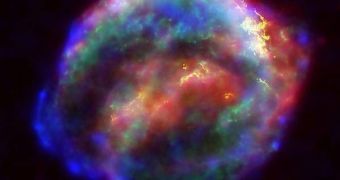Gamma-rays are the most energetic form of radiation in the Universe, and they have the potential to considerably light up the sky, if you know where to look for them. However, it's impossible to see them with conventional observatories. If traced with a gamma-ray telescope, they can show galactic and stellar processes, as well as the death of stars, either close by or near the beginning of the Universe.
Astronomers have recently figured out that “dark” gamma-ray bursts, which mostly shine in the gamma-ray and X-ray parts of the electromagnetic spectrum, can hint at the hidden processes that take place inside stellar nurseries, the areas of intense stellar formations usually found at the core of galaxies, in areas known as active galactic nuclei (AGN). One of the most interesting traits of these types of radiation is the fact that they can pass through cosmic gas and dust on account of their energy.
Because ultraviolet and optical light operate at lower wavelengths than these radiations, they cannot pass through the large dust clouds that envelop stellar nurseries. Visible light coming in from these active areas is also blocked by the clouds, and cannot reach us, LiveScience reports.
“Our study provides compelling evidence that a large fraction of star formation in the universe is hidden by dust in galaxies that do not appear otherwise dusty,” University of California in Berkeley (UCB) expert Joshua Bell, one of the team members, said in a new study on gamma-rays.
All of the 14 “dark” bursts that were analyzed came from galaxies that were visible to optical telescopes, which means that it was not their redshift that made them appear dark. These types of high-energy radiation had the same afterglow effects as other X-rays and gamma-rays, the researchers added. Additionally, the team concluded that the amounts of dust surrounding stellar nurseries must be much larger than originally estimated through other measurement techniques.

 14 DAY TRIAL //
14 DAY TRIAL //